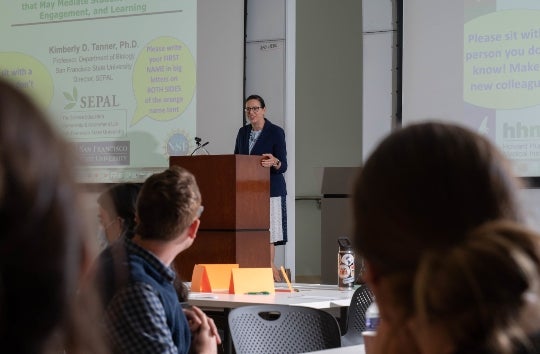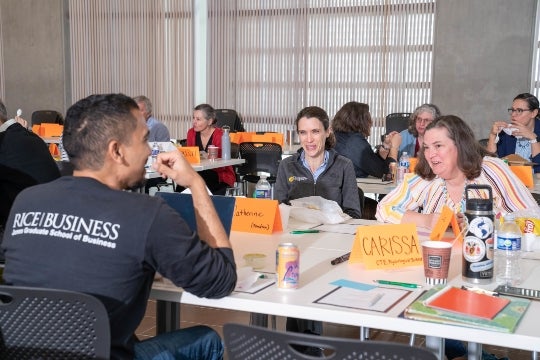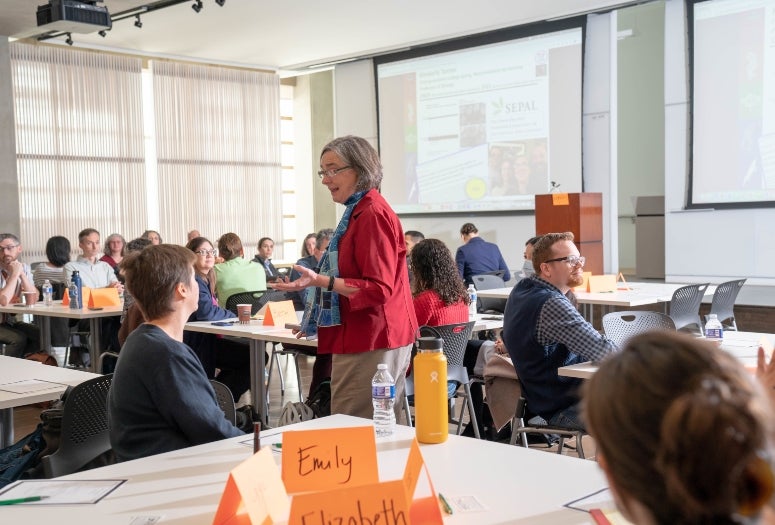Just because someone is a master in their field does not equate to seamlessly teaching the same knowledge to a room of college students. To truly turn an audience of pupils into an engaged group of active learners, a few pointers are paramount.
That was Kimberly Tanner’s overarching message at the Rice University Center for Teaching Excellence’s 10th annual symposium on teaching and learning Jan. 6 at Brockman Hall.

Tanner is a rotating program officer in the division of undergraduate education at the National Science Foundation, on leave from her position as a tenured professor of biology at San Francisco State University. Her laboratory — SEPAL: the Science Education Partnership and Assessment Laboratory — investigates what is challenging to learn in biology; how biologists choose to teach; and how to make equity, diversity and inclusion central in science education efforts. As a science faculty member with an education specialty, she is engaged in discipline-based education research, directs multiple biology education reform efforts for students of all ages and is deeply engaged in faculty professional development.
While she approached the workshop from a biology researcher’s standpoint, Tanner noted that the lessons were universal for instructors in multiple subjects, especially when considering the potential power of the teacher-student relationship.
Her discussion covered “instructor talk,” diving into not just what professors teach but also whom they teach and how students learn. She homed in on how to transition bystander learners into engaged classroom participants, especially in large and information-dense courses such as introductory science classes where a professor’s depth of subject matter expertise doesn’t automatically translate to effective instruction.
“Undergraduate students often appear to be treated as interchangeable entities without acknowledgment of the central role of the individual students, their learning histories and their personal characteristics in the student-centered nature of how professors aspire to teach,” Tanner said. “Each student’s prior experience, attitude and motivation toward the material being learned, confidence in his or her ability to learn and relative participation in the learning environment are all thought to be key variables in promoting learning of new ideas, biological or not. Bringing together individual students in classrooms produces group interactions that can either support or impede learning or different individuals.”
Her research shows that beyond the core academic lessons, the language professors use shapes classroom environments, affecting student motivation, resistance, sense of belonging and self-efficacy.

Tanner and her team observed over 60 courses, systematically investigating instructor language that was not directly related to course content. They identified five robust categories of communication that can characterize approximately 90% of this “instructor talk”: building instructor/student relationships, establishing classroom culture, explaining pedagogical choices, sharing personal experience and unmasking science.
Tanner further broke down the five main categories into 21 suggested methods to address the challenges, and she employed several of them during her lecture to the more than 100 attendees.
Examples included the following:
- Think-pair-share: Teachers should provide an opportunity for students to first think quietly and then share their ideas with a partner, which can help them rehearse and build confidence to share with the whole class, increasing participation.
- Multiple hands, multiple voices: After instructors ask a question, they should wait for at least five students to raise their hands before calling on anyone — and really wait for five students’ hands to raise.
- Use popsicle sticks or index cards: Teachers write the name of every student in their class on an individual popsicle stick or index card and put them in a cup. When asking a question, they pull out two to five sticks or cards to randomly call on students.
- Integrate culturally diverse and relevant examples: Connect the concepts being taught to real-world examples that span diverse communities and cultures.
“As instructors, we have the power in our classroom to choose to attend explicitly to issues of access, inclusiveness, fairness and equity,” she said. “The strategies presented are merely starting points from which instructors can step up their attempts to cultivate equitable classroom environments that promote student engagement and participation.”

